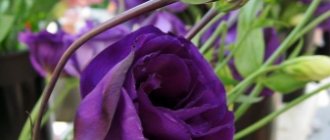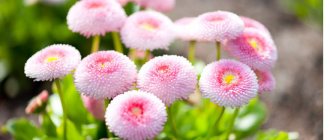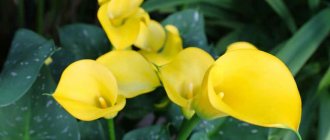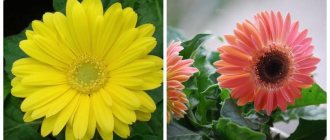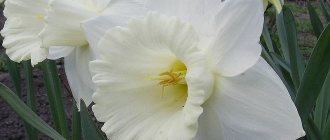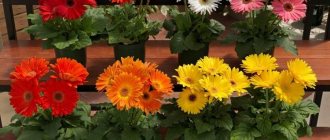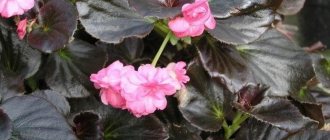What do gerbera flowers look like?
- Gerbera is very similar to chamomile. But unlike the white petals of chamomile, gerbera has a different color
- There are white, scarlet, pink, yellow and other gerberas. Almost all varieties are distinguished by bright colors
- Gerbera belongs to the Aster family, so there are similarities with lush asters
- Low-growing varieties are ideal for growing indoors. However, it is worth noting that the height of the gerbera stem can reach 60 cm
- The diameter of the flowers ranges from 4 to 12 cm
Gerbera indoors
general description
This is a herbaceous, perennial plant belonging to the Asteraceae family. The root system is strong and developed. Gerbera is characterized by its compact size and shortened stem. A dense rosette of light greenish leaves is formed in the root zone. Tall, strong, slightly pubescent peduncles grow from the middle of the rosette. Flowers bloom on them - single, large baskets with a light, yellowish-green core.
The flowers are similar in appearance to daisies (nivyanika) and somewhat reminiscent of echinacea. Gerberas come in a variety of colors and sizes; there are regular, double and semi-double. The exception is blue - a flower in nature never acquires this color.
Are gerberas perennial or annual?
Important: In open ground, gerberas are grown in greenhouses. Constant changes in climatic conditions are not acceptable for this plant. Indoor gerberas live much longer.
Gerbera can be an annual or perennial plant. If we are talking about open ground, then gerberas can please the eye only for one year - in the summer. In winter, the roots must be dug up and placed in a basement with a suitable temperature. In this case, there should be an earthen lump on the roots. This is the only way the roots can survive.
Indoor gerbera is a perennial plant. The plant will live a long time if you take proper care
Rules for sowing seeds
Jameson's gerbera seeds do not need any preparation. Unlike other flowers, such as Turkish carnations or rhododendrons, they retain the ability to germinate for a very short time - a maximum of eight months, which makes it somewhat difficult to obtain a good result. Sow seedlings around the beginning of March, since this flower has a long growing season.
For planting seedlings, medium-sized containers or boxes are used. The seeds are distributed on the surface of the moistened soil and covered with a layer of sand no more than five millimeters thick. Next, moisturize from a spray bottle and cover with a transparent film on top. Germination occurs within ten days at a temperature of about twenty-two degrees Celsius, during which the crops are ventilated daily.
After the emergence of shoots, the film is removed, and after some time, when the first pair of true leaves are formed, Jameson's gerbera is picked into separate flower pots, leaving the root collar strictly at the same level with the ground. Ten days after transplantation, the first fertilizing with universal mineral complexes is performed.
Like the related Echinacea officinalis, they are transferred to the main place of growth in the garden in early summer, since even late frosts can destroy fragile plants. Planted in single or group plantings, leaving an interval of about twenty centimeters.
Video. Caring for indoor gerbera
Further flower care consists of watering and protection from pests. Among the latter are spider mites, aphids and whiteflies. The first can be combated by increasing air humidity, and in other cases insecticides can be used.
In winter, Jameson's gerbera requires a period of rest, and therefore in the fall it is again transplanted into pots and sent to a room with an air temperature of about ten degrees Celsius until spring.
When planted in early March, the flowering of Jameson's gerbera will begin only at the end of August and will last until the first frost, and sometimes it blooms only in the second year. It will bloom indoors for about four months.
Gerbera: the meaning of the flower, what it symbolizes, signs
Important: It is generally accepted that every flower means something. For example, carnations are traditionally considered a mourning flower; roses mean love.
Gerbera has a positive meaning:
- Represents joy and lightness
- If a man gives a woman gerberas, we can assume that he is interested in her
- Another meaning of the flower is flirtation, mystery
There are several versions of the origin of the flower:
- The genus was named after the German botanist and physician Traugott Gerber. Traugott Gerber was a researcher of the flora of the Volga region, and also served as director of the botanical garden in Moscow
- The second version of the name comes from the Latin word “herba”, which means grass
- In some English-language sources, gerbera is called “Transvaal daisy”
Varieties of gerbera
If you want to give a gerbera in a pot to your relatives, friends, but at the same time you believe in omens, do not doubt it. Because gerbera represents the best qualities.
Gerberas in a pot: how to care, what kind of soil is needed, how often to water?
Experienced gardeners do not see any difficulties in growing indoor gerberas. But if you are new to floriculture, you should know some care tricks.
Watering
- Excessive watering is inappropriate. If water stagnates in the pot, fungal diseases of the plant can develop. Also, excessive watering can lead to yellowing of the leaves.
- Poor watering, in turn, leads to a state of dormancy. Gerbera will stop blooming
- Water the flower along the edge of the pot, as gerberas are prone to fungal diseases
Important: The secret to watering gerberas is to use warm, settled water. The water can be at room temperature, but in no case is it cold. If you water a gerbera with cold water, there will be a difference in air and water temperature, as a result of which the plant will begin to rot.
Care for gerbera at home
Lighting
- A lot of light and not direct sunlight is a prerequisite for the growth and flowering of gerbera
- In the summer, it is advisable to place the flower on the balcony or loggia so that there is access to fresh air.
- In the winter season, when there is very little light, it is advisable to support the gerbera with fluorescent lamps
- The normal temperature for gerberas is 24°
The soil
- The following soil mixture is used: leaf soil with the addition of peat, sphagnum or purified sand
- It is unacceptable to add compost or humus to the mixture.
- Choose magnesium sulfate as a fertilizer; at low temperatures you can fertilize with phosphorus
- Fertilizer concentration should be weak
- There is no need to fertilize gerberas in winter.
Reproduction methods
New specimens of gerberas can be obtained in 3 ways:
- Seeds. We will talk about this in more detail below. A flower grown in this way will bloom for the first time only after almost a year. For cultivation, you can use seeds collected with your own hands.
- By cuttings. To preserve the characteristic characteristics of hybrid varieties, when propagation by seeds is not suitable, cuttings are used. To do this, cut off a part of the stem with a node and a leaf, and then root it in the ground.
- By dividing the rhizome. To do this, remove the adult plant from the soil and separate the roots. This method, as well as cuttings, helps to obtain a varietal plant with similar characteristics.
Read more about all methods of gerbera propagation in our material.
Gerbera seeds are elongated in shape with a fluffy tassel at the end. The size is small, one gram contains from 300 to 500 pieces.
Pollination of an indoor flower
Gerbera is not a self-pollinating plant, since its reproductive organs mature at different times. Therefore, to obtain seeds, artificial cross-pollination is required during the flowering period.
Ripe pollen can be used within 100 days. You can store it in a clean, dry glass container with a lid. To maintain a variety, both plants must belong to the same species. If this is not possible, you can use what is available.
In this case, the result is unpredictable; the resulting seeds can produce a completely different plant in terms of characteristics. For pollination at home, ripe pollen from one flower is transferred to another flower.
You can simply collect pollen with a brush and “smear” the middle of another flower. It’s better to do this several times during flowering to be sure. Ripe pollen can be seen by the protrusion of the center of the flower with yellowing.
When do they ripen?
A gerbera seed ripens 3-4 weeks after successful pollination. Accordingly, this happens in the fall at the end of flowering (you can find out when and how long gerberas bloom and why they don’t do this here).
How to collect?
As soon as the center of the flower becomes fluffy like a dandelion, you can collect the seeds by carefully disassembling the flower with your hands. Gerbera seeds quickly lose their viability, so they need to be planted within 6 months after collection.
How much are?
Having looked through a bunch of offers on the Internet for selling seeds, I can give an approximate price range for gerbera seeds from 22 to 89 rubles per package containing 10-25 seeds. Varieties: Gerbera Jameson, Festival, Rays, Californian Giant. The seeds are mostly in the form of mixtures, meaning it is unknown what color palette you will get.
Below you can see photographs of gerbera and its seeds.
Gerbera pot: which one to choose?
We should also talk about a pot for growing gerbera. It is known that it is undesirable to use pots after other plants, as they may contain disease spores. Therefore, you need to replant the gerbera into a new pot.
The pot must meet the following requirements:
- Must be free
- It is necessary to have a tray that will not come into contact with the pot (pallet on a stand)
Important: Although the plant does not like overwatering, a certain humidity must be maintained constantly. The right pot helps in this matter. Place pebbles on a tray and pour water over them. If the tray is not in contact with the pot, the roots will not absorb the water, but it will still be a moist environment.
Transfer
Florists advise not to rush into replanting your home gerbera soon after purchasing it. Every plant needs some period of time to adapt to new living conditions, and our flower is no exception. Replanting once a year, preferably in February, is quite acceptable in order to place the plant in a larger pot using the transfer method. The bottom of the vessel should be filled with a generous layer of drainage. Experienced flower growers chose a special pot for gerberas with a hole at the bottom for external watering. This allows you to avoid stagnation of moisture at the surface of the roots, which is detrimental to the root system.
Different plants prefer their own soil for planting, and Jameson's gerbera will be content with light, but at the same time nutritious soil. You can buy ready-made soil for roses in the store, since these flowers have similar soil requirements. If you decide to prepare the mixture with your own hands, then a recipe will do, containing equal parts of leaf and peat-containing soil, as well as coarse sand. It wouldn't hurt to add hydrogel, or at least pine bark. When planting, it is important not to bury the leaf rosette and promptly clear it of any soil that has fallen into it.
Why do indoor gerbera leaves turn yellow and dry: what to do?
Gerbera leaves turn yellow and dry if they are attacked by pests :
- Whitefly . The plant should be treated with a preparation containing permethrin.
- Spider mite . To get rid of it, spray the leaves 2-3 times a day with clean water. If this does not help, you need to use the drug Actellik
Important: Yellowing occurs when overwatering. Reduce watering if your gerbera begins to wilt and turn yellow.
Diseases and pests
Garden gerbera is very sensitive to diseases and pests. Many diseases can occur due to improper care. The soil is treated before planting to avoid fungal diseases of the root system. The most common gerbera diseases:
- Powdery mildew. Occurs from excessive moisture in the soil. As the temperature rises, rotting begins. Symptoms - the leaves become limp, yellowed, covered with spots and a white coating. Treatment with fungicides or sulfur-containing preparations can help in the early stages of the disease. In more advanced cases, the affected leaves are removed.
- Gray rot. Characterized by the appearance of a gray coating and wilting of leaves. It can be prevented if regularly treated with special compounds. The main thing is that the chemical does not get on the inflorescences.
Among the pests that gerberas suffer from are whiteflies, aphids, and spider mites. The leaves of affected plants turn yellow and become covered with spots and holes. It is possible to remove insects using insecticides.
Advice! You should not cut gerbera flowers; it is better to break them out of the nest. If a piece of the peduncle remains on the bush, the entire plant will begin to rot.
Gerberas: growing in open ground in the garden, at the dacha
Growing gerberas in open ground is not an easy task. These are annual plants, so they will have to be sown every year. And seed germination will depend on weather conditions. As you know, gerbera needs light and warmth.
When cold weather sets in, you can dig up the roots of the gerberas and try to save them until next year. This is what they do with dahlias, for example. However, gerbera roots need to be stored in a dry place with a ball of earth; they need to be covered with straw and a layer of dry leaves. The temperature at the storage location should be about 8º.
Important: In Africa, gerberas grow on their own, but the climate of Russia and many other countries does not allow gerberas to grow without problems.
Growing in open ground
Care
Since the natural habitat of the gerbera differs significantly from the conditions in the apartments of Russian lovers of growing flowers, a reasonable question arises about how to properly care for the Jameson gerbera. It becomes important to learn some secrets and tips from experienced flower growers.
The main points of care are set out in the following requirements:
- temperature - moderate, during flowering 16-20°C, in winter not lower than 12°C;
- lighting - bright diffused light, needs additional lighting in autumn and winter;
- watering - abundant all the time;
- air humidity - the leaves are not sprayed, the tray is filled with wet pebbles;
- propagation - by seeds in spring, by dividing the bush and cuttings.

